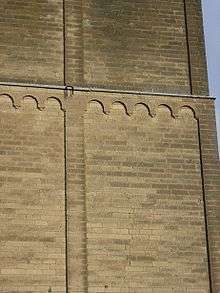Lesene

A lesene – also called a pilaster strip[1] – is an architectural term for a narrow, low-relief, vertical pillar in a wall. It resembles a pilaster, but does not have a base or capital.[2]
Function
Lesenes are used in architecture to divide a facade or other wall surface optically, albeit - unlike pilasters - without a base or capital. Their function is ornamental, not just to decorate the plain surface of a wall but, in the case of corner lesenes, to emphasise the edges of a building.
Gallery
-

Lesenes and corbel table on a chapel wall
-

Lesenes and corbel table at the Mausoleum of Galla Placidia in Ravenna (ca. 430 AD)
-

Lesene on the staircase tower of the Gernrode collegiate church (before 1000 AD)
-

Lesenes on the Abbey church of Maria Laach (1156)
- Modern and post-modern
-

Robin Hood Gardens, London – Lesene-shaped formation on the supporting wall in the Plattenbau style
-

Lesenes at Chile House, Hamburg
References
- ↑ Glossary of Medieval Art and Architecture
- ↑ Curl, James Stevens (2006). Oxford Dictionary of Architecture and Landscape Architecture, 2nd ed., OUP, Oxford and New York, p. 442. ISBN 978-0-19-860678-9.